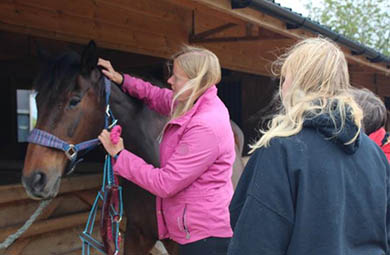Select tab
About
This Lantra-accredited Customised Award is exclusively developed and delivered by a Lantra-approved Training Provider, who meets our quality standards. The course is specifically tailored to meet learners’ needs. For further details about the course content and delivery locations, please contact the Training Provider using the details provided below.
The minimum age to undertake this course is 16.
The Advanced course is the third of three training programmes leading to a Practitioner accreditation.
Each programme builds on the skills learnt in the previous two programmes.
On successful completion of each programme, a Lantra Certificate of Achievement is awarded.
When all three programmes are completed the Learner can then apply to the Equine Touch Foundation (ETF) to become a licensed Equine Touch Practitioner.
The finer details
Home Study Learning and Research:
Understanding the horse and a more detailed application of Equine Touch
At this stage, a learner should be able to show more detailed knowledge of the application of Equine Touch, be able to clearly discuss the modality, and show competence in using ET in different situations.
The Learner must building ET sessions by drawing on all practical training, home study work, and theoretical study to date and, by so doing, illustrating the level of competency required to achieve Equine Touch Practitioner status.
As they progress through the programme, the learner should be demonstrating the ability to think like a practitioner. An essay illustrating their journey and personal reflections is included in the assessment criteria.
Anatomy & Physiology includes research into: the nervous, cardiovascular, alimentary and genito- urinal systems; the detailed anatomy of the distal limb, horse’s head and mouth, horse’s spine, and the biomechanics of movement in relation to training and saddle fit.
- The aim is to achieve a complete picture of the horse’s anatomy and gain understanding of the influencing factors acting on the horse’s body.
- To gain knowledge of how these systems function and affect the overall well-being of the horse, and how they may be influenced by bodywork.
- This understanding will help an ET practitioner to be a valued member of the multidisciplinary teamwork approach required in maintaining a horse’s wellbeing.
Who should attend?
The Practical Course is suitable for:
- Any person interested in or involved with horses
- Anyone looking for practical skills to help their own horses
- Anyone wishing to offer Equine Touch as a professional service to others or who already has qualifications in other related disciplines and wishes to add to their portfolio of skills for the equine must register on the Practitioner Training Route and complete ongoing practical and theoretical training and assessment in order to gain Lantra certification at the end of each Programme.
What will be covered?
The Practical Course is suitable for:
- Any person interested in or involved with horses
- Anyone looking for practical skills to help their own horses
- Anyone wishing to offer Equine Touch as a professional service to others or who already has qualifications in other related disciplines and wishes to add to their portfolio of skills for the equine must register on the Practitioner Training Route and complete ongoing practical and theoretical training and assessment in order to gain Lantra certification at the end of each Programme.
Practical Skills
- Demonstrate and perform all skills from Foundation, Intermediate and Advanced programmes;
- Demonstrate the ability to communicate with the horse owner in given scenarios with emphasis on thinking like a Practitioner;
- Combine skills learnt from all three programmes to address specific issues revealed by the horse.
Equine Touch Theory
Understand:
- The terms ‘a compensation animal’; ‘muscle memory’ and ‘healing crisis’;
- The significance of elements of ‘the circle of influence’ on the horse’s body and how these other factors may influence the effectiveness of an Equine Touch session;
- How Equine Touch, as well as being physical body work, relates to elements of ‘energy’ work;
- How Equine Touch may be used as a means of changing the emotional/mental balance of the horse and its‘ reactions/relationships with the trainer/owner/other horses in the herd.
Applied Anatomy & Physiology
Understand:
- How training and different types of competition can impact on the equine
- Cautions or contraindications of using Equine Touch.
Anatomy & Physiology
Understand:
- Recognise what is considered to be signs of pain or discomfort shown by a horse;
- Explain the nature of a ‘reflex’ reaction and the difference between that and a ‘pain’ reaction
Research and understand the basics of the equine:
- circulatory system
- lymphatic system
- digestive system
- reproductive system
- nervous system
- skeletal system.
Understand:
- The structure and function of teeth and jaw
- The anatomy of the equine back to include the biomechanics of equine movement with, and without, a saddle
- The effects on the horse’s back of a poorly-fitting saddle
- The effects of ‘conditioning' on the horse’s body
- How growth plates affect maturity in the horse
- The action of different types of joint in the horse
- The anatomy, function and mechanics of movement of the equine’s legs
- The structure and function of the horse’s hoof
- Summarise your training experience in the form of an essay titled: ‘What Equine Touch Means to Me’.
For further information visit www.equinetouchuk.com/coursedatesequinetouch or contact the learning support hub on learningcoordinatoretf@gmail.com
Search for providers near you
If there are no suitable courses listed above, please fill in the details below and this will display a list of other course providers who also deliver this course.



